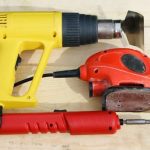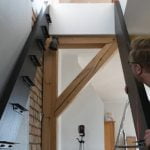In today’s digital age, coding is no longer limited to just creating websites or apps. It has now found its way into our homes, allowing us to embark on exciting do-it-yourself (DIY) projects that seamlessly blend technology and home improvement. Welcome to the world of DIY coding home improvements, where you can unleash your creativity and technical skills to transform your living space.
The link between coding and home improvement may not be immediately obvious to everyone. However, when you delve deeper, you’ll discover the endless possibilities that arise from this combination. From smart home integration to enhancing security systems, optimizing energy consumption, customizing entertainment setups, automating household chores, and even troubleshooting common challenges – all of these can now be achieved through coding.
If you’re new to this concept or unsure where to start, understanding the basics is key. In the following sections, we will break down the relationship between coding and home improvement. We will explore how essential tools and resources can empower you in your DIY coding journey. Additionally, we will guide you through various aspects of coding projects that enhance different areas of your home.
So whether you’re a tech enthusiast looking for new ways to revolutionize your living space or a homeowner wanting to save time and money on small-scale projects, this article will serve as your comprehensive guide. Get ready to dive into the world of DIY coding home improvements and unlock a whole new level of innovation within your own four walls.
Understanding the Basics
When it comes to home improvement projects, many people may not immediately think of coding as a useful skill. However, the link between coding and home improvement has become increasingly evident in recent years. By understanding the basics of coding, homeowners can unlock a world of possibilities for enhancing their living spaces.
At its core, coding involves writing sets of instructions for computers to follow. These instructions can be used to create software, apps, websites, and much more. In the context of home improvement, coding allows homeowners to automate tasks, integrate smart devices, enhance security systems, optimize energy consumption, and customize entertainment systems.
One of the main areas where coding is utilized in home improvement is through home automation systems. With the advancements in technology, it has become easier than ever before to control various aspects of a home with just a few lines of code. For example, homeowners can program their lights to turn on automatically when they walk into a room or set up voice commands to control their smart thermostats.
In addition to automation, coding also plays a significant role in enhancing home security systems. By utilizing sensors and cameras along with programming skills, homeowners can set up DIY security solutions that fit their specific needs. This could involve creating an alarm system that sends notifications directly to their smartphones or programming surveillance cameras to record footage when motion is detected.
| Benefits | Data |
|---|---|
| Average Energy Savings with Smart Thermostats | 10-15% |
| Percentage of Americans using Voice-Activated Assistants | 22% |
| Percentage decrease in burglaries with smart home security systems | 39% |
As homeowners become more familiar with the basics of coding, they can explore endless possibilities for DIY coding home improvements. With the right tools and resources, anyone can elevate their living space to new heights by incorporating coding into their projects. In the following sections, we will dive deeper into the essential tools and resources needed to get started with DIY coding home improvements.
Getting Started
Getting started with DIY coding home improvements can seem overwhelming, but having the right tools and resources is essential to make the process smoother. Here are some essential tools and resources that you will need to embark on your coding journey:
Hardware
To start your DIY coding projects, you’ll need a reliable computer or laptop. Make sure it has enough processing power and memory to handle coding software. Additionally, having a microcontroller board like Arduino or Raspberry Pi can be beneficial for connecting your code to physical devices.
Software
There are several programming languages you can learn for DIY coding home improvements, such as Python, JavaScript, or C++. Choose a language that aligns with your project goals and interests. Install Integrated Development Environments (IDEs) like Visual Studio Code or Atom to write and test your code efficiently.
Online Learning Platforms
There are plenty of online learning platforms and resources available for beginners in coding. Websites like Codecademy, Coursera, and Udemy offer courses specifically tailored for DIY home improvement enthusiasts. These platforms provide structured lessons, exercises, and projects that allow you to learn at your own pace.
Online Communities and Forums
Joining online communities and forums dedicated to DIY coding home improvements can provide valuable support and insights from experienced hobbyists and professionals in the field. Websites like GitHub, Stack Overflow, and Reddit have active communities where you can ask questions, share ideas, collaborate on projects, and find inspiration.
Documentation
As with any coding project, it’s important to refer to documentation regularly. Each hardware device or programming language often has its own documentation that provides guidance on syntax, functions, libraries, and APIs that you can utilize in your projects. Taking the time to understand the documentation will help you troubleshoot issues and expand your coding skills.
By having these essential tools and resources at your fingertips, you will be well-equipped to dive into the world of DIY coding home improvements. Remember, learning to code is a continuous process, so don’t be afraid to experiment, make mistakes, and learn from them. With time and dedication, you’ll be able to create impressive and personalized enhancements for your living space.
Smart Home Integration
In today’s digital age, smart home technology has become increasingly popular among homeowners. With the help of coding, you can take your smart home integration to the next level, transforming your living space into a highly efficient and automated environment. Whether you’re a coding novice or an experienced developer, there are countless opportunities for DIY coding home improvements that can enhance the comfort, convenience, and security of your home.
One of the first steps in smart home integration is understanding the basics of coding. Familiarizing yourself with programming languages such as Python or JavaScript will give you the foundation you need to start creating custom solutions for your smart devices. Online tutorials and coding courses are readily available resources that can help you learn the necessary skills at your own pace.
Once you have a grasp of coding fundamentals, it’s time to explore the essential tools and resources needed for DIY coding home improvements. A reliable computer or laptop is essential, along with software like an integrated development environment (IDE) that allows you to write and test code efficiently. Additionally, investing in microcontrollers like Arduino or Raspberry Pi can provide endless possibilities for connecting and controlling various devices in your home.
To make full use of smart home integration, it’s important to consider how different technologies can be interconnected. Utilize HTML unordered lists when exploring various options:
- Connect key devices such as thermostats, lighting systems, and entertainment units through a central hub.
- Integrate voice control assistants like Amazon Alexa or Google Assistant to interact with your smart devices hands-free.
- Establish communication protocols such as Bluetooth or Wi-Fi within your network to ensure seamless connectivity.
By utilizing these strategies as part of your DIY coding projects, you can effortlessly create a cohesive experience throughout your living space.
Overall, smart home integration provides an exciting opportunity for homeowners to optimize their living spaces by leveraging coding skills. From controlling lighting and temperature to automating everyday tasks, DIY coding home improvements offer endless possibilities for enhancing comfort, convenience, and security. With the right tools, resources, and a bit of creativity, you can truly transform your home into a futuristic oasis.
Home Security Enhancements
Introduction to Home Security Enhancements
In an increasingly connected world, home security has become a top priority for many homeowners. Thankfully, with the power of coding and DIY projects, there are now countless opportunities to enhance the safety of your home using your own skills and creativity. By combining coding knowledge with common household devices, homeowners can create innovative solutions that provide added protection for their living spaces.
Creating a DIY Coding Home Security System
One of the most effective ways to improve home security through coding is by developing a custom home security system. With basic programming skills and easy-to-use microcontrollers like Arduino or Raspberry Pi, homeowners can build a personalized system tailored to their specific needs. By integrating sensors, cameras, and alarms, you can create a comprehensive monitoring system that protects your property from intruders.
When it comes to building your DIY coding home security system, there are several components you’ll need to consider:
- Sensors: These include motion sensors, door/window sensors, and even biometric scanners for enhanced access control.
- Cameras: Incorporating cameras into your system allows you to monitor your property remotely and capture evidence in case of any suspicious activity.
- Alarms: Audible alarms can alert both you and potential intruders that unauthorized entry has occurred.
- Communication: To receive real-time notifications or connect your system to existing smart devices in your home, you may need to incorporate wireless communication modules such as Wi-Fi or Bluetooth.
Enhanced Security Features with Coding
Aside from the basic components of a home security system, coding enables homeowners to add advanced features that further enhance security measures. For example:
- Facial recognition technology: By using machine learning algorithms and computer vision techniques, homeowners can train their systems to recognize familiar faces and send alerts when an unfamiliar face is detected.
- Voice recognition: Integrating voice recognition systems allows for hands-free control and the ability to verify authorized users.
- Intrusion detection: Coding can help create algorithms that analyze data collected from sensors to identify patterns and detect potential intrusions, sending alerts when suspicious activities are detected.
With DIY coding solutions for home security enhancements, homeowners have the freedom to create custom security systems that cater to their specific needs and preferences. By utilizing coding skills, individuals can take an active role in protecting their homes and loved ones.
Energy Efficiency
The Importance of Energy Efficiency
In today’s world, energy efficiency has become a crucial aspect of homeownership. Not only does it help reduce the environmental impact, but it also allows homeowners to lower their energy costs. Incorporating coding into home improvement projects can significantly contribute to optimizing energy consumption. By leveraging coding skills, homeowners can create smart systems that monitor and control various aspects of energy usage in their homes.
Smart Thermostats and Temperature Control
One area where coding can greatly improve energy efficiency is in temperature control. Smart thermostats have gained popularity in recent years, allowing homeowners to regulate the heating and cooling of their homes more efficiently. With the power of coding, homeowners can take this control to the next level.
By integrating smart thermostats with coding knowledge, homeowners can create personalized schedules for temperature adjustments based on their daily routines. Additionally, coding can enable features such as geofencing, which detects when everyone has left the house and automatically adjusts the temperature accordingly.
Lighting Optimization
Another significant factor contributing to energy consumption is lighting. Traditional lighting systems rely on manual switches or timers to turn lights on and off. However, with coding skills, homeowners can automate their lighting systems to optimize energy usage. For instance, by using motion sensors and programming them through coding techniques, lights can be set to turn on only when someone is present in a room and automatically turn off after a certain period of inactivity.
Moreover, by utilizing smart bulbs and platforms that integrate with coding languages like Python or JavaScript, homeowners can create complex lighting schedules that adjust brightness levels based on natural daylight or change colors depending on specific events or moods. This level of customization not only enhances energy efficiency but also adds a unique touch to the overall ambiance of a home.
By harnessing the power of coding in home improvement projects focused on optimizing energy consumption, homeowners can save money, reduce their carbon footprint, and create a more comfortable living environment. In the next section, we will explore how coding can be applied to customize home entertainment systems.
Customizing Home Entertainment
In today’s digital age, home entertainment systems have become a central part of our lives. From streaming movies and TV shows to enjoying immersive audio experiences, technology has transformed the way we enjoy entertainment in the comfort of our own homes. By combining coding skills with DIY projects, homeowners have the opportunity to customize and enhance their home entertainment systems in unique and creative ways.
To begin customizing your home entertainment system using coding, you will need a few essential tools and resources. Firstly, it is important to have a basic understanding of programming languages such as Python or JavaScript, as these are commonly used in coding projects. Online tutorials and courses can provide you with the necessary knowledge to get started.
Once you have familiarized yourself with coding basics, there are several coding projects you can undertake to enhance your audio and visual systems. One popular project is creating a custom media player using Raspberry Pi.
With this small computer, you can build your own media center that supports various file formats and streaming services. By writing code for different functionalities like controlling playback or displaying metadata on a connected screen, you can create a personalized media experience tailored to your needs.
Another coding project that can elevate your home entertainment system is creating an ambient lighting system that synchronizes with the content you are watching on your TV or monitor. This involves connecting LED light strips around your screen and utilizing code to analyze the video being displayed and generate corresponding lighting effects.
Whether it’s enhancing the mood during movie nights or adding an extra layer of immersion during gaming sessions, this coding project allows you to take your viewing experience to new heights.
Automating Household Chores
Automation has become an essential aspect of modern living, and coding can play a significant role in automating various household chores. By utilizing coding techniques, homeowners can save time and effort by streamlining everyday tasks. Here are some time-saving coding solutions that can help automate household chores:
- Laundry Automation: With the help of sensors and coding, you can create a system that alerts you when your laundry is done. By attaching sensors to your washing machine and dryer, you can receive notifications on your phone or even trigger actions such as folding or ironing at the end of the cycle.
- Schedule Cleaning Tasks: Overwhelmed by multiple cleaning tasks? You can create a coding solution that automates your cleaning schedule. By using smart home devices and coding platforms, you can set up routines that activate robotic vacuums or other cleaning tools at specific times, ensuring a consistently clean home.
- Grocery Shopping Made Easy: Coding can simplify your grocery shopping experience by creating automated shopping lists. With the help of an app or website, you can generate a shopping list based on recipes or frequently purchased items. This not only saves time but also reduces the chances of forgetting essential items.
By harnessing the power of coding for household chores, homeowners can enjoy more free time and reduce stress. However, it is crucial to note that these automation solutions may require some level of technical expertise and familiarity with coding languages such as Python or JavaScript.
To get started with automating household chores through coding, here are some essential tools and resources:
- Coding Languages: Familiarize yourself with languages like Python or JavaScript which are commonly used for home automation projects.
- Coding Platforms: Explore coding platforms such as Arduino or Raspberry Pi, which provide a user-friendly environment for creating and executing coding solutions.
- Online Tutorials and Communities: Take advantage of the vast resources available online, including tutorials, guides, and forums where you can find support and inspiration from fellow DIY enthusiasts.
Through these resources and tools, homeowners can embrace DIY coding to automate household chores effectively. By utilizing innovative solutions and embracing the intersection of technology and home improvement, homeowners can transform their living spaces into efficient, time-saving havens.
Enhancing Home Automation Systems
Home automation systems have become increasingly popular in recent years, allowing homeowners to control various aspects of their living space with ease. However, for those looking to take their home automation to the next level, advanced coding techniques can provide seamless integration and enhanced functionality. This section will explore some of the ways that coding can be used to enhance home automation systems.
One area where advanced coding techniques can make a significant impact is in integrating different smart devices within a home automation system. By writing custom code, homeowners can connect devices from different manufacturers and create a unified ecosystem that works harmoniously. For example, using coding techniques, it is possible to synchronize smart lights, thermostats, and security cameras so that they work together seamlessly.
Another benefit of advanced coding techniques in home automation is the ability to create personalized experiences tailored to individual preferences. With coding knowledge, homeowners can develop custom applications or scripts that automate specific tasks or routines based on their unique needs and preferences. For instance, one may create a script that automatically adjusts the temperature settings based on the time of day and occupancy patterns.
In addition to customization and integration, advanced coding techniques also open up possibilities for expanding the capabilities of existing home automation systems. By utilizing APIs (Application Programming Interfaces) provided by various smart device manufacturers, homeowners can access additional features and functionalities not typically available through standard user interfaces. This allows for greater flexibility and creativity in designing an automated living space.
| Benefit | Description |
|---|---|
| Integration of different smart devices | By writing custom code, homeowners can connect devices from different manufacturers and create a unified ecosystem that works harmoniously. |
| Personalized experiences | Coding knowledge allows homeowners to develop custom applications or scripts that automate specific tasks or routines based on their unique needs and preferences. |
| Expansion of capabilities | Advanced coding techniques enable homeowners to access additional features and functionalities not typically available through standard user interfaces by utilizing APIs provided by smart device manufacturers. |
Troubleshooting and Tips
In the world of DIY coding home improvements, it is not uncommon to face challenges along the way. Whether you are a seasoned coder or just starting out, it is important to be prepared for these common hurdles and know how to overcome them. This section will provide troubleshooting tips and solutions for some of the most common challenges that DIY coders may encounter.
One common challenge that DIY coders often face is debugging their code. Debugging involves identifying and fixing errors or bugs in your code that prevent it from working as intended. It can be frustrating trying to figure out why your code isn’t running properly, but there are several strategies you can use to troubleshoot and fix the issue.
First, it is important to carefully review your code line by line to spot any syntactical errors or typos. Sometimes a simple misplaced character or missing semicolon can cause your entire code to break. Additionally, using print statements throughout your code can help you track the values of variables at different points in the program, which can be useful in identifying where the issue may lie.
Another common challenge in DIY coding home improvements is compatibility issues with different devices or software systems. When integrating coding into your home automation or entertainment systems, it is crucial to ensure that all components are compatible and able to communicate with each other effectively.
To tackle this challenge, research and thorough planning are key. Before beginning a coding project, gather information about the devices or systems you plan to integrate and check for any compatibility issues. It may also be helpful to consult user forums or communities dedicated to DIY coding projects for guidance on how others have successfully addressed similar compatibility challenges.
Finally, one of the most vital aspects of successful DIY coding home improvements is staying updated with relevant technologies and best practices. Technology evolves rapidly, and what may be cutting-edge today could become outdated tomorrow. Keeping up-to-date with coding languages, frameworks, and tools will help you stay ahead of the curve and maximize the potential of your DIY coding projects.
Regularly reading technology blogs, participating in online coding communities, or attending coding workshops can provide valuable insights and keep you informed about the latest trends and advancements. Additionally, staying connected with other DIY coders can create opportunities for collaboration and knowledge sharing.
| Challenge | Solution |
|---|---|
| Debugging code | – Carefully review code line by line
|
| Compatibility issues | – Research devices/systems for compatibility before starting a project
|
| Staying updated with technology | – Read technology blogs regularly
|
Conclusion
In conclusion, the intersection of DIY projects and coding presents homeowners with a unique opportunity to transform their living spaces. By understanding the basics of coding and utilizing essential tools and resources, homeowners can enhance their homes in various ways. From smart home integration and home security upgrades to energy efficiency optimizations and customizing home entertainment systems, coding opens up a world of possibilities.
One of the key benefits of DIY coding home improvements is the ability to customize and personalize your living space. With coding skills, homeowners can create unique solutions that cater to their specific needs and preferences. Whether it’s programming smart devices to automate tasks or developing advanced techniques for seamless integration within a home automation system, DIY coding empowers homeowners to take control and build a space that truly reflects their lifestyle.
Moreover, embracing DIY coding also offers cost-saving opportunities. Many off-the-shelf products for home automation or security enhancements can be costly. However, by taking on DIY coding projects, homeowners have the chance to save on expenses while gaining valuable skills along the way. This not only allows them to add value to their homes but also gives them a sense of satisfaction in knowing they accomplished these improvements themselves.
Frequently Asked Questions
What home projects add the most value?
When it comes to home projects that add the most value, there are several key areas to focus on. One of the most significant is kitchen remodeling. Updating outdated appliances, countertops, and cabinets can instantly enhance the overall appeal and functionality of a kitchen, which is a major selling point for many buyers.
Another valuable project is bathroom renovation, as modernizing fixtures, adding storage space, and improving overall aesthetics can greatly increase a home’s value. Additionally, improving curb appeal through landscaping enhancements and adding outdoor living spaces like decks or patios can significantly boost a property’s value.
Do home improvements increase equity?
Yes, home improvements can indeed increase equity in a property. Equity refers to the amount of ownership one has in their home that exceeds any outstanding mortgage balance.
By making strategic home improvements that enhance the property’s market value, homeowners effectively increase their equity stake in the house. It’s important to note that not all improvements will generate substantial returns on investment; therefore, it’s crucial to focus on upgrades that have high-value potential and cater to popular buyer preferences in order to maximize equity gains.
How can I increase the value of my home by $50 000?
Increasing the value of a home by $50,000 requires careful planning and consideration of various renovation options. One effective way to achieve this goal is by focusing on expanding livable space within the existing structure. For example, finishing an underutilized basement or attic space can add additional square footage without altering the property’s footprint significantly.
Other options include updating kitchens and bathrooms with high-end fixtures and finishes or investing in energy-efficient upgrades such as solar panels or insulation improvements—these not only boost value but also reduce utility costs over time. Ultimately, researching local real estate market trends and consulting with professionals such as real estate agents or contractors can provide valuable guidance on specific projects that will yield substantial returns in increasing a home’s overall value by $50 000.

I’m thrilled to have you here as a part of the Remodeling Top community. This is where my journey as an architect and remodeling enthusiast intersects with your passion for transforming houses into dream homes.





